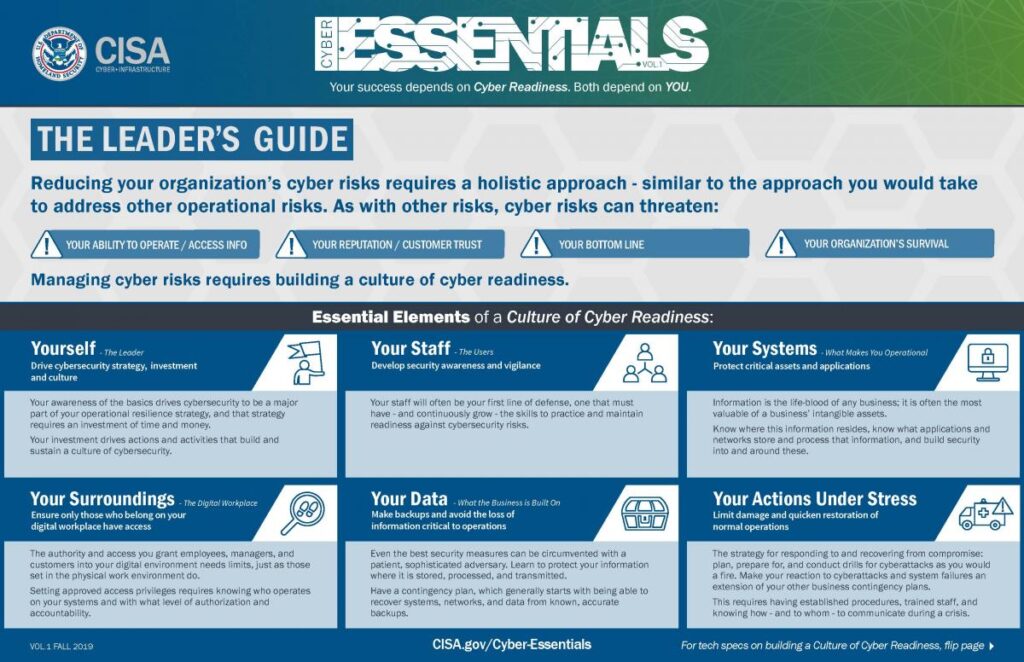
Introduction
Cybersecurity has become a critical concern for businesses of all sizes. With the increasing frequency and sophistication of cyber-attacks, organizations must have the necessary tools and resources to protect their sensitive data and systems. CISA helps businesses defend against cyber threats by providing tools and resources.
Understanding the Threats
Cybercrime comes in various forms, each with its own unique impact on businesses. Cyber-attacks can cause great harm, ranging from ransomware that locks important data until a ransom is paid, to phishing scams that deceive employees into revealing private information. Not only can they result in financial losses, but they can also damage a company’s reputation and erode customer trust.
Recent years have seen a surge in high-profile cyber-attacks that have affected businesses across industries. For example, the 2020 SolarWinds attack compromised the networks of numerous government agencies and private companies, highlighting the vulnerability of even the most secure systems. Similarly, the 2021 Colonial Pipeline ransomware attack disrupted fuel supplies along the East Coast of the United States, causing widespread panic and economic disruption.
CISA’s Role in Cybersecurity
CISA’s mission is to protect the nation’s critical infrastructure from cyber threats. The agency works closely with other government agencies, private sector organizations, and international partners to identify and mitigate cyber risks. CISA helps businesses strengthen their cybersecurity posture and respond effectively to cyber incidents by providing guidance, tools, and resources.
Collaboration is a key aspect of CISA’s approach to cybersecurity. The agency works closely with federal, state, local, tribal, and territorial governments and private sector partners to share information and coordinate efforts. This collaborative approach ensures that businesses can access the latest threat intelligence and take proactive measures to protect their systems and data.
The Components of CISA’s Arsenal
CISA’s arsenal consists of many tools and resources designed to help businesses stay safe in the digital landscape. One such tool is the Cyber Hygiene program, which provides organizations with best practices for securing their networks and systems. This program covers topics such as patch management, network segmentation, and user access controls, helping businesses implement effective cybersecurity measures.
Another important component of CISA’s arsenal is the Continuous Diagnostics and Mitigation (CDM) program. This program provides federal agencies and participating organizations with tools and resources to monitor their networks, identify vulnerabilities, and respond to cyber threats in real-time. By implementing the CDM program, businesses can enhance their cybersecurity posture and reduce the risk of a successful cyber attack.
Cybersecurity Best Practices
In addition to the tools and resources provided by CISA, businesses can implement several best practices to protect themselves against cyber threats. One of the most important is employee education and training. To reduce the risk of an attack, businesses should educate their employees about common cyber threats and teach them how to recognize and respond to them.
Regularly updating software and systems is another crucial best practice. Many cyber-attacks exploit vulnerabilities in outdated software, so keeping systems up-to-date with the latest patches and security updates is essential. Additionally, implementing strong access controls, such as multifactor authentication, can help prevent unauthorized access to sensitive data and systems.
Threat Intelligence
CISA’s Arsenal includes a robust threat intelligence program that helps businesses stay ahead of cybercriminals. By monitoring the latest threats and vulnerabilities, CISA provides businesses with timely information and actionable insights to protect their systems and data. This threat intelligence is shared through various channels, including alerts, advisories, and reports, ensuring businesses can access the most up-to-date information.
Staying up-to-date on the latest threats and vulnerabilities is crucial for businesses to defend against cyber-attacks effectively. Cybercriminals constantly evolve their tactics, so businesses must remain vigilant and adapt their cybersecurity measures accordingly. By leveraging the threat intelligence provided by CISA, businesses can proactively identify and mitigate potential risks before they can be exploited.
Incident Response
Despite the best preventive measures, it is still possible for a business to fall victim to a cyber-attack. In such cases, having a well-defined incident response plan is essential. An incident response plan outlines the steps to be taken during a cyber incident, ensuring that the organization can respond quickly and effectively to minimize the impact.
CISA’s Arsenal encompasses a comprehensive collection of resources and invaluable guidance aimed at assisting you in the development of an exceptional incident response plan. This includes identifying key stakeholders, establishing communication channels, and defining roles and responsibilities. With a plan in place, businesses can reduce downtime, mitigate the damage caused by an attack, and restore normal operations as quickly as possible.
Cybersecurity Training and Education
Empowering employees with the knowledge and skills to stay safe online is crucial for maintaining a strong cybersecurity posture. CISA offers various training and education programs to help businesses educate their workforce on best practices and emerging threats. These programs cover topics such as phishing awareness, secure coding practices, and incident response.
By investing in cybersecurity training and education, businesses can create a culture of security where employees are actively engaged in protecting sensitive data and systems. This not only reduces the risk of a successful attack but also enhances the overall cybersecurity posture of the organization.
CISA’s Partnerships
CISA recognizes that combating cybercrime requires a collaborative approach. The agency works closely with other government agencies, private sector organizations, and international partners to share information, coordinate efforts, and develop effective strategies to address cyber threats.
One example of successful collaboration is the National Cybersecurity and Communications Integration Center (NCCIC), which serves as a hub for sharing information and coordinating incident response efforts. Through the NCCIC, CISA works with federal, state, local, tribal, and territorial governments and private sector partners to respond to cyber incidents and mitigate their impact.
Conclusion
In conclusion, cybersecurity is a critical concern for businesses in today’s digital landscape. With the increasing frequency and sophistication of cyber-attacks, organizations must have the necessary tools and resources to protect their sensitive data and systems. CISA’s Arsenal provides businesses with comprehensive tools and resources to defend against cyber threats, including threat intelligence, incident response guidance, and cybersecurity training programs.
By leveraging CISA’s Arsenal and implementing best practices, businesses can significantly reduce the risk of a successful cyber-attack. However, it is important to remember that cybersecurity is an ongoing process that requires constant vigilance. Staying up-to-date on the latest threats and vulnerabilities, collaborating with other agencies and organizations, and investing in employee education and training are essential for maintaining a strong cybersecurity posture. By doing so, businesses can protect their sensitive data and systems and ensure the continuity of their operations.





